Introducing the thin client
Thin clients have long and firmly taken their place in modern business. But just in case, we recall the main points in order to warn the possible question "Why is all this necessary?".
In the broad sense of the word, “Thin Client” is any software or hardware tool that allows operation in the terminal mode. This implies the existence of a server that performs all the calculations, as well as organizes a virtual workplace. A thin client needs to be distinguished from a “fat client,” which uses its own computational power, and the server only uses it to store data.
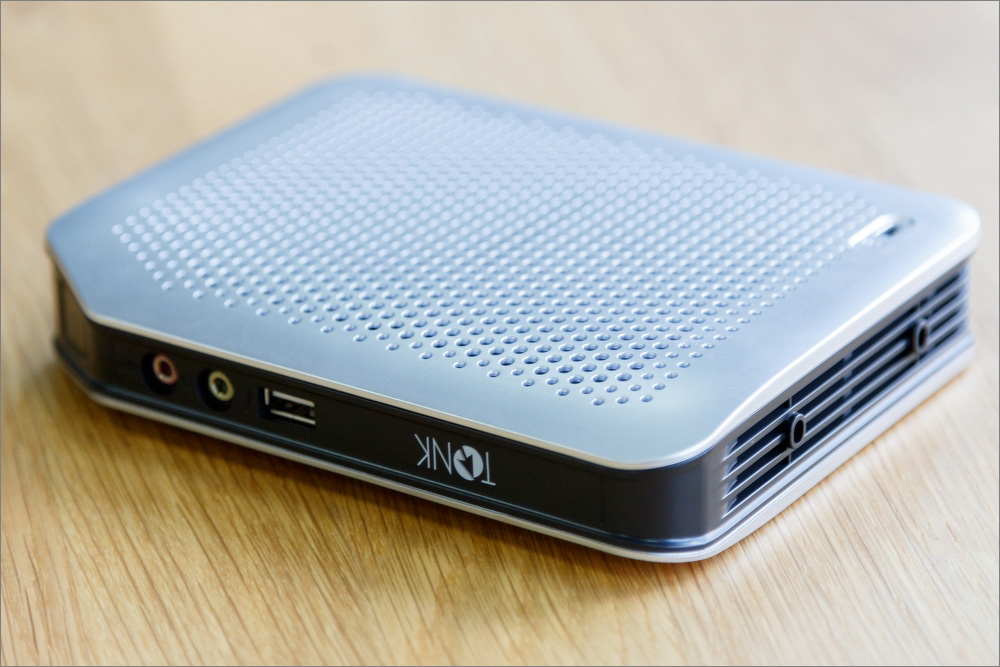
')
The most interesting are the so-called hardware thin clients - devices that mostly differ from the classic PC in that they do not have a hard disk and use a specialized local operating system, the main task of which is to organize access to a remote desktop.
A thin client must not have moving parts in its composition, be compact, have low power consumption and its cooling must be completely passive.
From here following advantages follow:
Today we will talk about the TN1202 thin client from the Russian company TONK. This is the youngest model in the Lenaze 1200, which also includes the TN1207 and TN1221 .
The device is sold in a compact corrugated cardboard box. All components of the delivery kit are neatly fixed in place using packaging elements made of polyethylene foam.

The package includes a power supply, an adapter from DVI-D to VGA, a VESA mount, a stand for vertical installation and an optional adapter from DVI to two monitors (DVI + DSUB),

The package bundle is not bad - unlike the competitors, it even has a VESA-bracket - to put it simply, there is everything to deploy the workplace, nothing more is needed. For obvious reasons, it was hardly necessary to include a keyboard, a mouse and a monitor in the kit.
Power supply - external. It is a universal (110-230 V) AC adapter, input voltage 12 V, maximum current consumption 3 A. Thus, the maximum power consumption 12V x 3A = 36W.
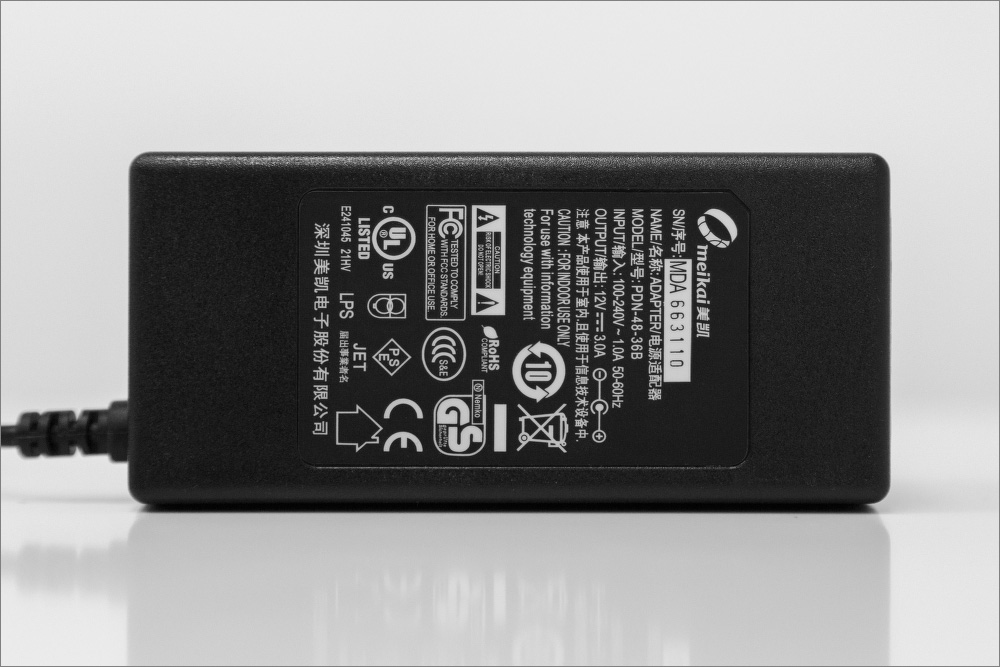
The external power supply in this case is preferable to the internal one, since this is the only place in the system that can theoretically fail. Of course, replacing it is much easier than sending the entire device to service.
Now let's move on to our “Thin Client”.
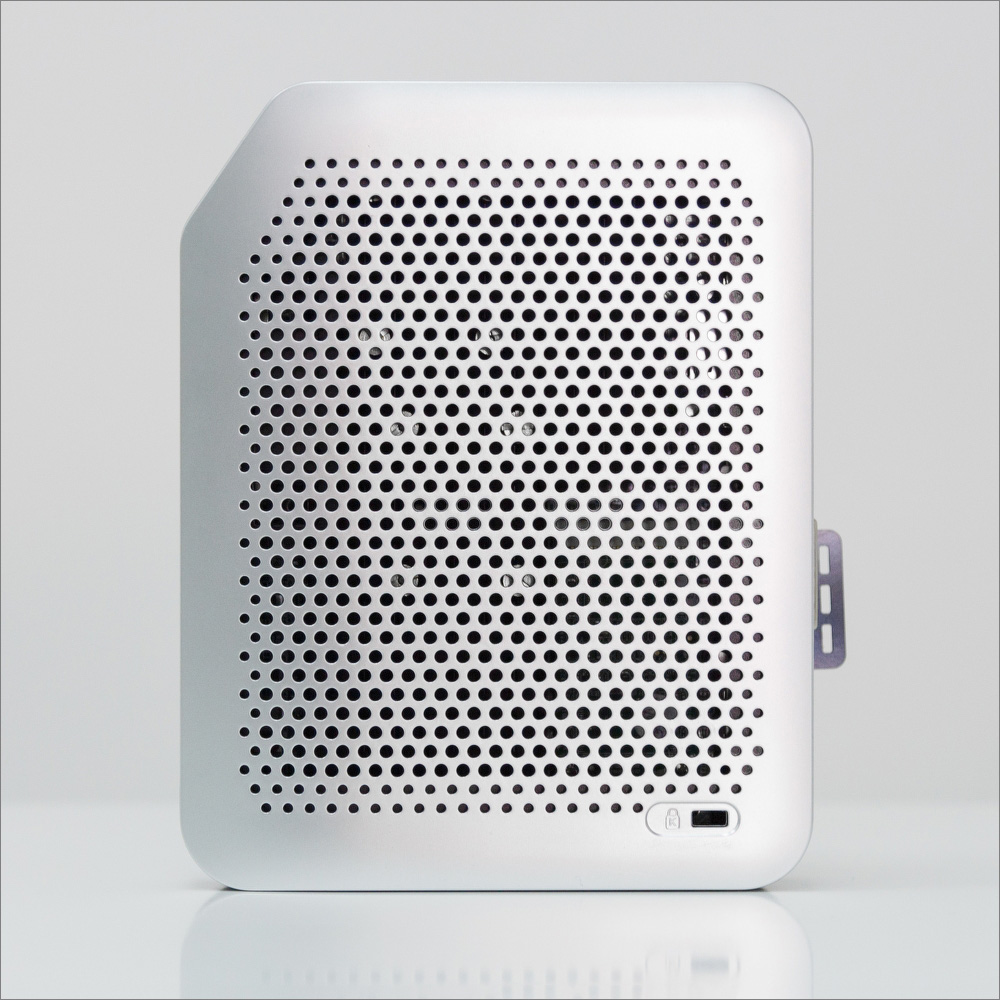
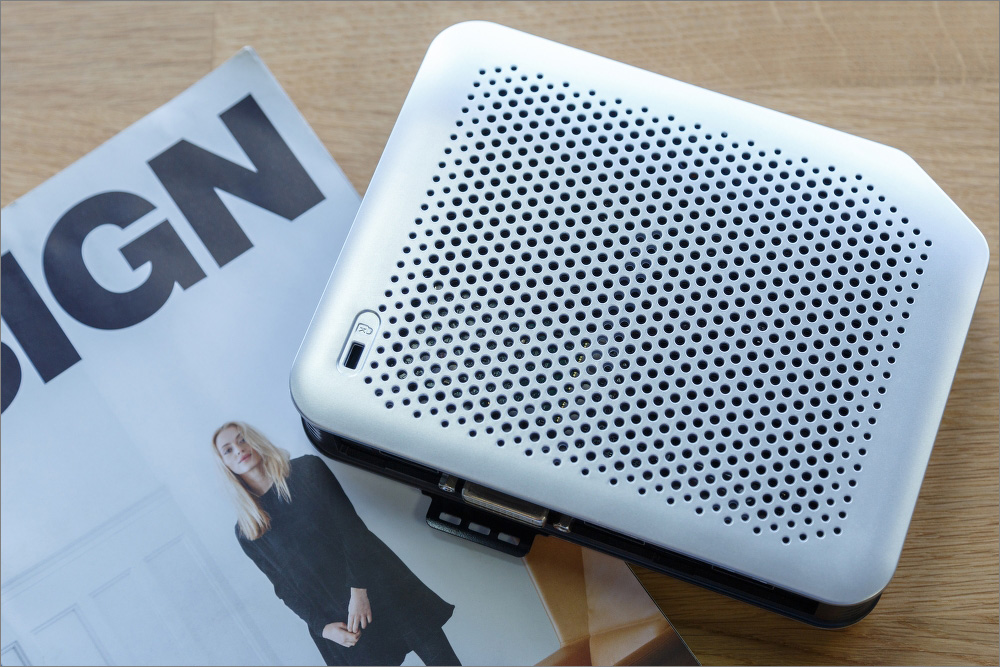
The device looks very stylish - one feels that they have worked on the design. Slightly spoils the impression of the color connectors of the microphone and headphones, but it would be strange if they were not. Also, metal instead of gray plastic would make a better impression. However, this is all subjective, and the practicality of color marking to someone may seem more important.
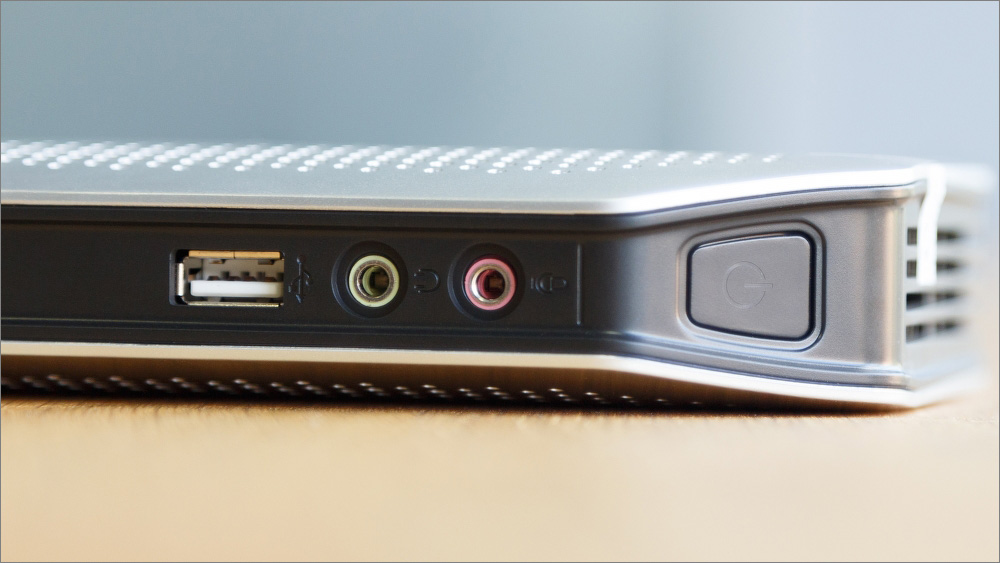
The quality of assembly and materials is at a high level, when you try to deform the device, nothing creaks or backlash.
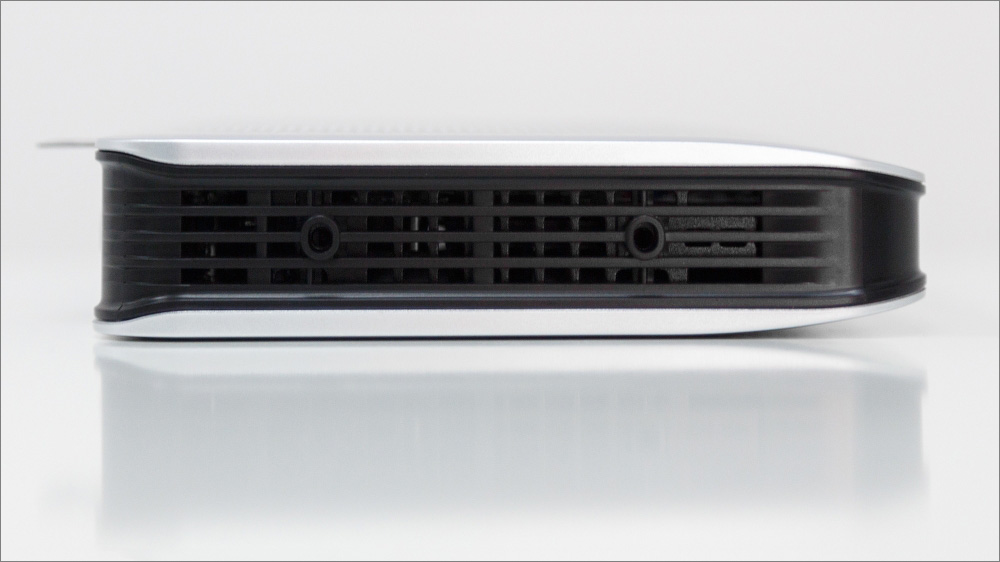

It stands out in a very compact size (31x167x131 mm), and with a modest weight - a little more than half a kilo. On one side is the “Kensington lock” connector, designed for anti-theft mounts (which is the standard in the corporate segment).
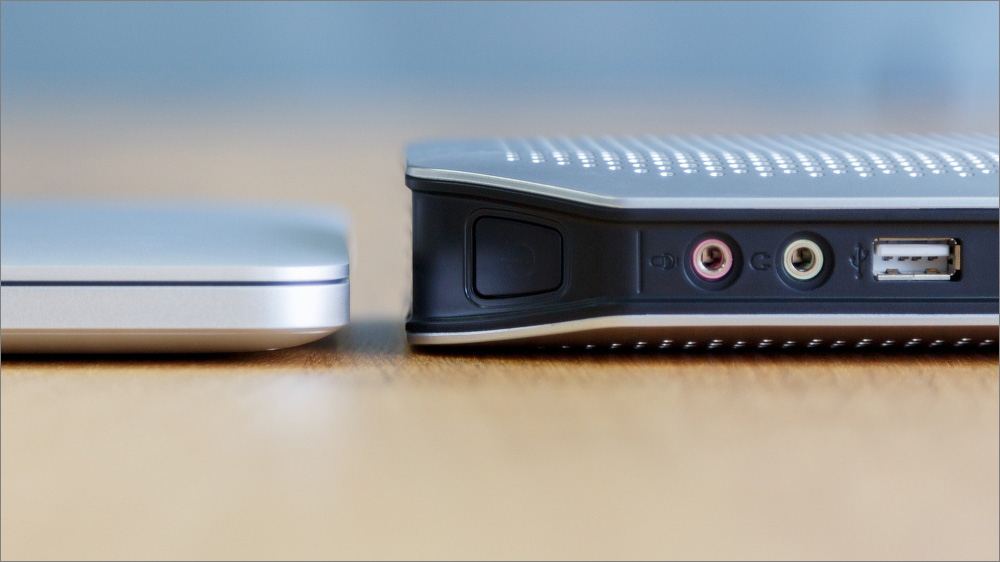
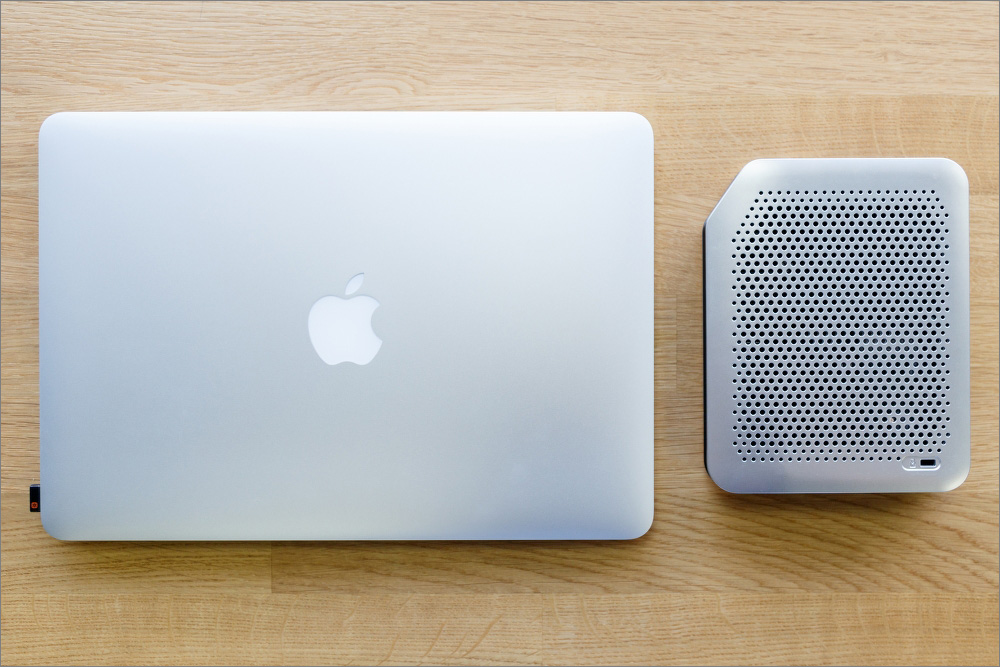
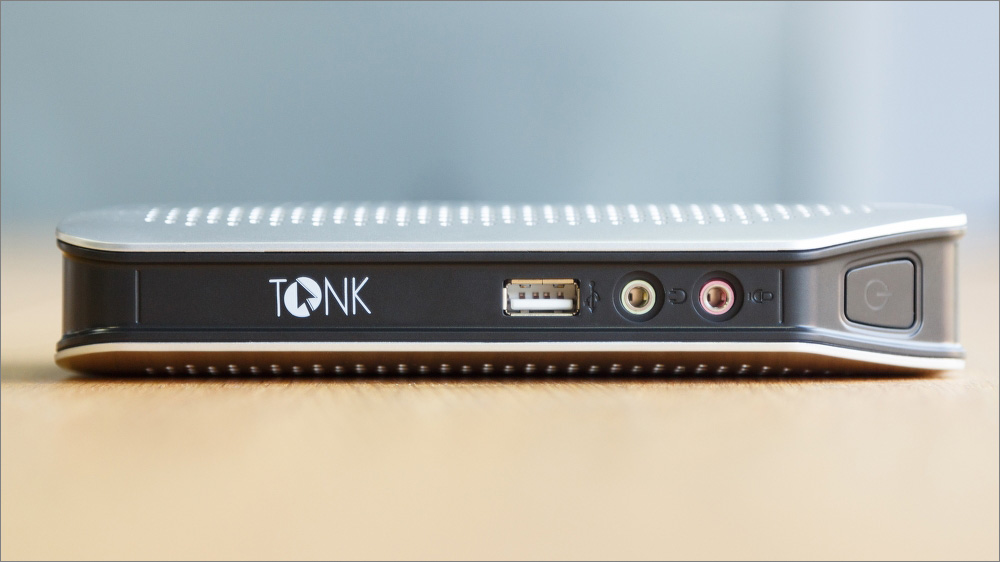
The front panel, in addition to the company logo, contains a USB port, headphone and microphone connectors, as well as a power button, combined with an LED indicator.

On the reverse side there are expansion connectors (from left to right): 2xUSB (2.0), Ethernet, again two USB, DVI, and two more USB ports and a power connector.
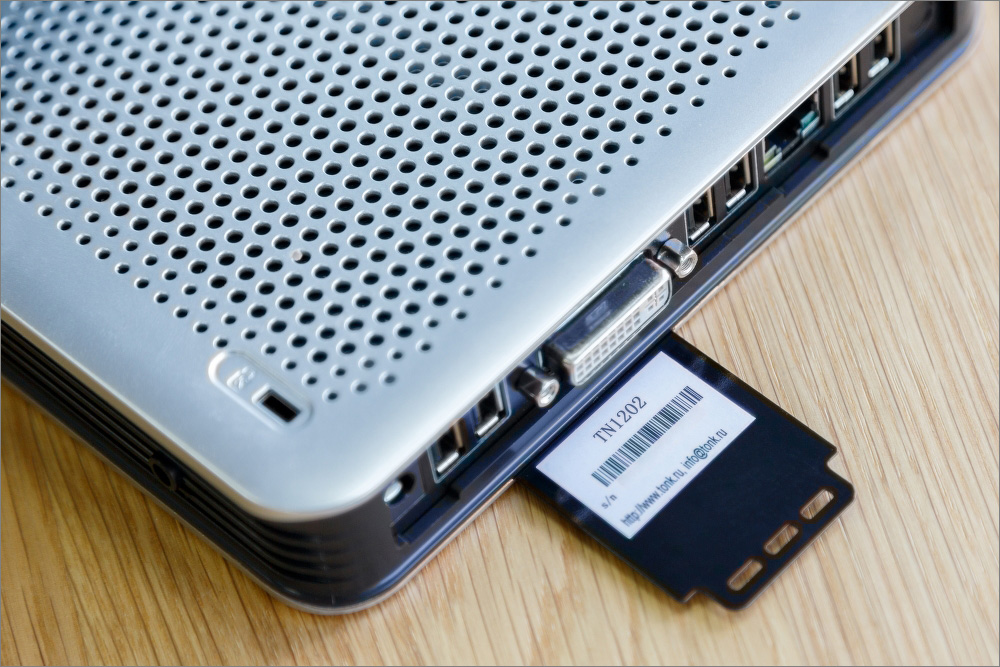
The photo is visible information plate, which is removed inside the case - it shows the model name and serial number. It is very convenient to place on it the inventory number, which is usually the IT-department glues everywhere.
The device can be installed in several ways - to whom it is more convenient. For example, just horizontally:

Or vertically as a nettop (using a stand from the kit):

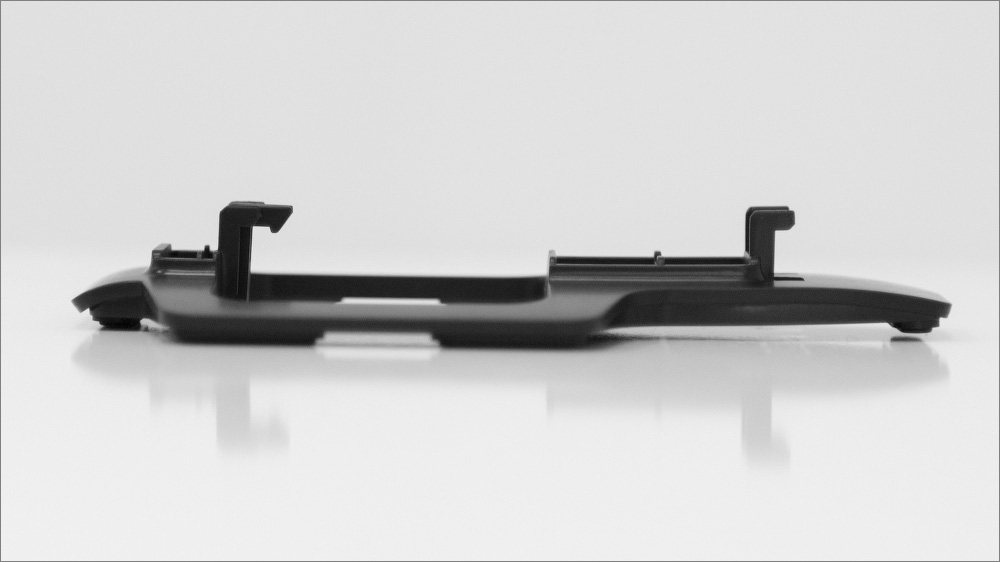
But the most elegant, in our opinion, installation option, which many other desktop systems cannot boast with is a VESA-bracket (the distance between mounting holes of which is 75x100 mm). This allows you to attach the device to most modern monitors - just twisting the screws through the adapter to the back of the monitor.
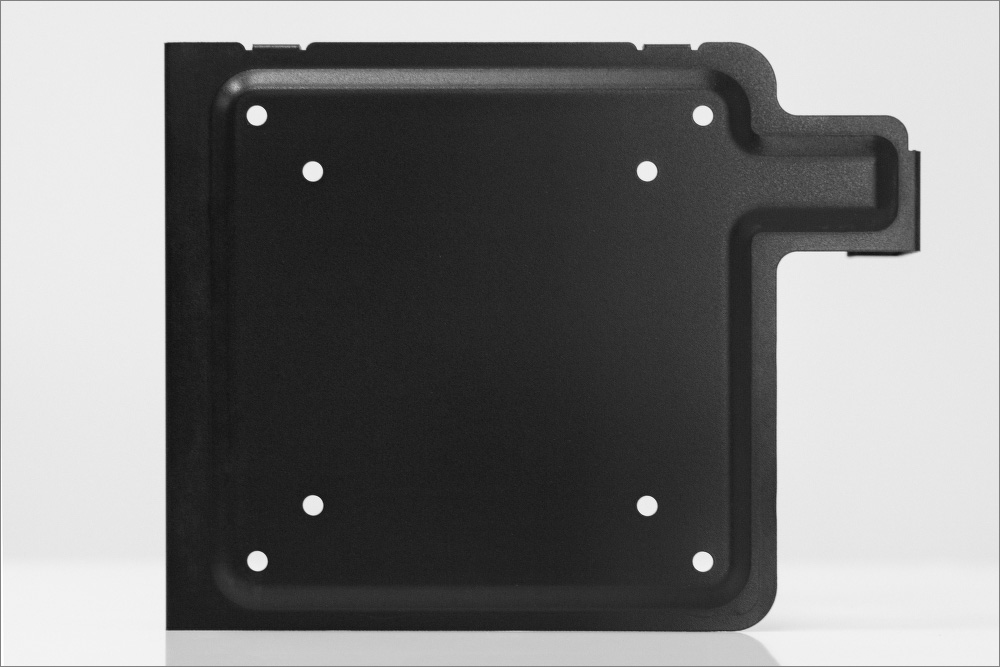
There are two colors to choose from:
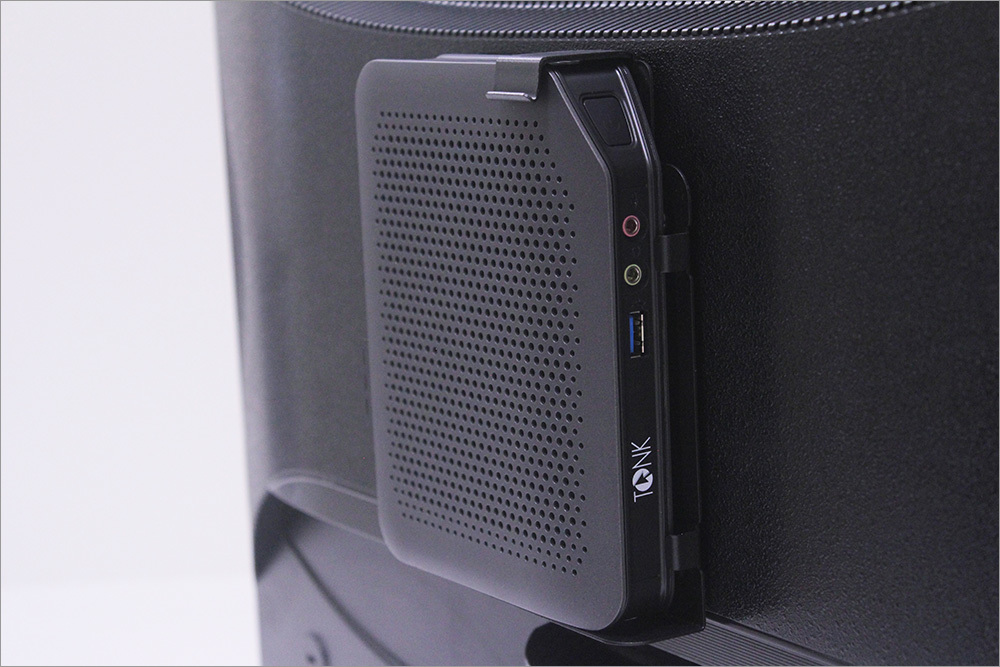
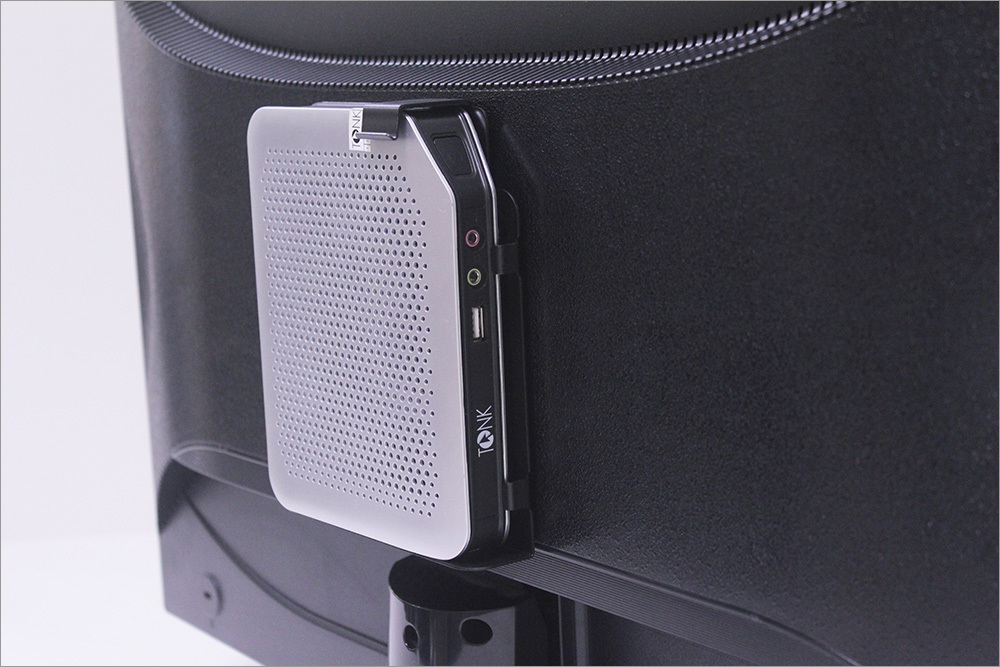
In a separate paragraph, I would like to mention a completely passive cooling system - this is one of the key advantages of thin clients. In large open spaces, even minimal noise from laptops and PCs merges into one annoying hum, which by the end of the working day is very tiring.
In addition, the lack of fans will not allow the system to fill the interior with dust, which means that you can save on periodic maintenance (cleaning).
AMD system-on-chip for embedded applications includes on a single physical substrate
Many may have a question about the appropriateness of using x86-processor (especially dual-core) in the thin client. It may be unnecessary to transfer a remote desktop image from the server, but as a rule, it is useful to have locally at least a browser, an instant messaging tool and an audio-video conferencing program for which certain computing power will not be superfluous.
When you press the power button, the successful device initialization is accompanied by a short loud squeak of the system dynamics.
System loading is very fast - the process takes about 7 seconds. There are no problems with connecting two monitors. The only point is that during the initial loading the image on the screens is duplicated - in the settings you need to select “Extend the desktop”.
If the device is not connected to the local network, the first thing that the user sees is a message about the need to insert a network cable.
The TN1202 client ships with TONK Embedded Linux operating system. Pre-configuration of connections to remote desktops and applications on the operating system (OS) pre-installed on the TN1202 TONK is possible as in the "kiosk" mode:
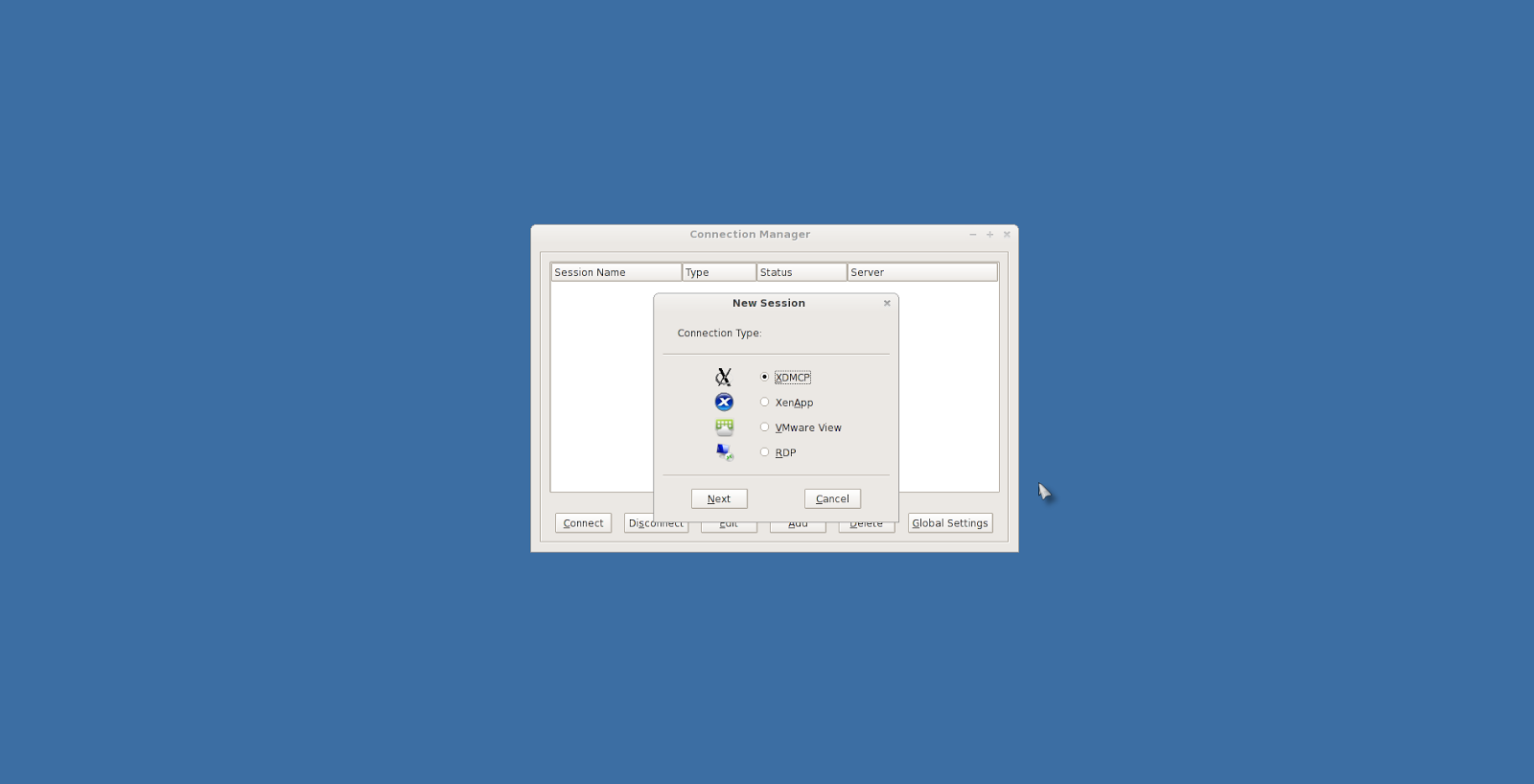
So in the “quasi-zero” client mode:
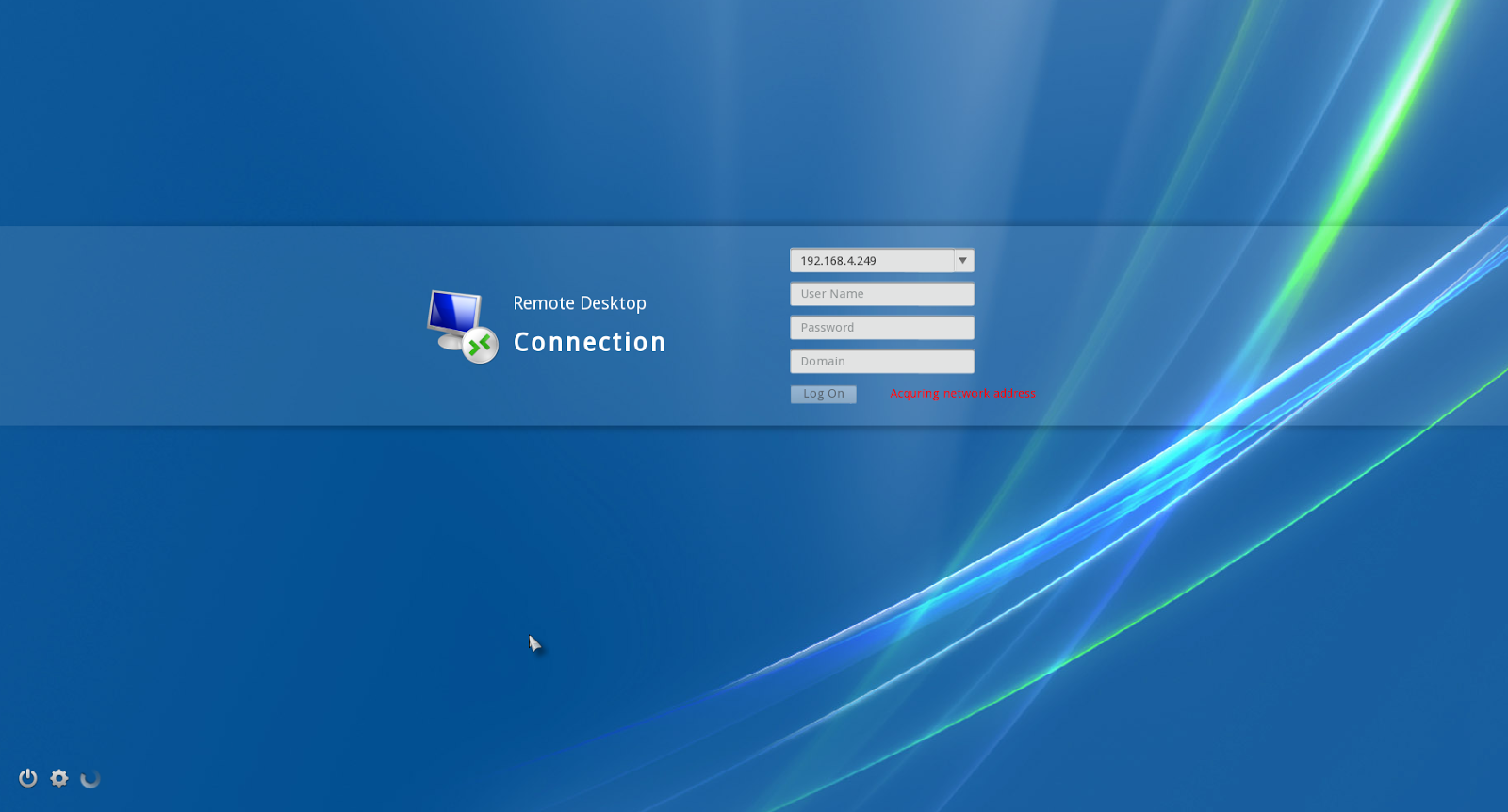
The second mode is possible both for working with Microsoft Remote Desktop Server resources and in Citrix and VMWare virtualization environments. After switching on the TONK, the user immediately enters the necessary application or virtual machine on a remote server, without displaying unnecessary interfaces.
A few more screenshots from the device for self-study (clickable):

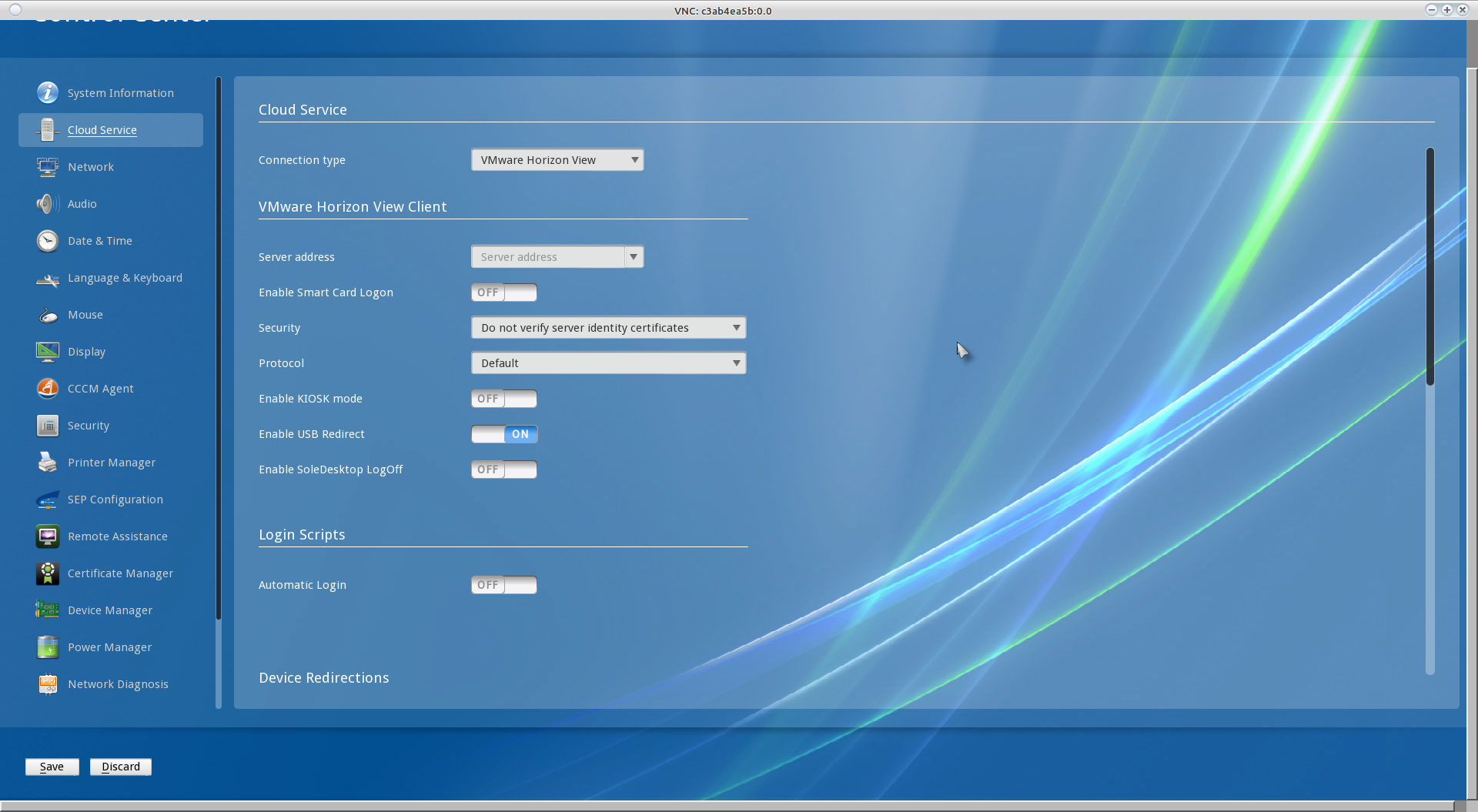
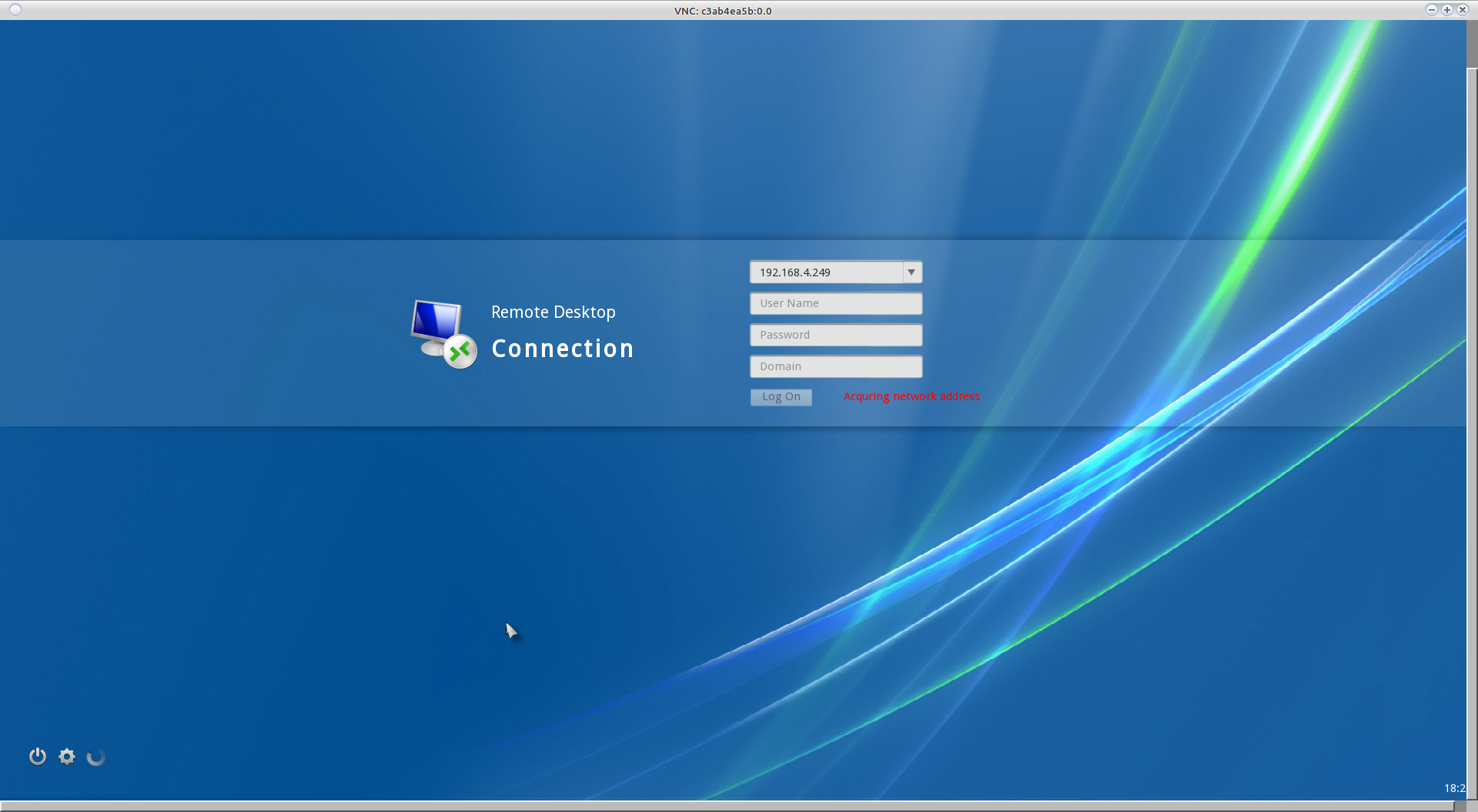
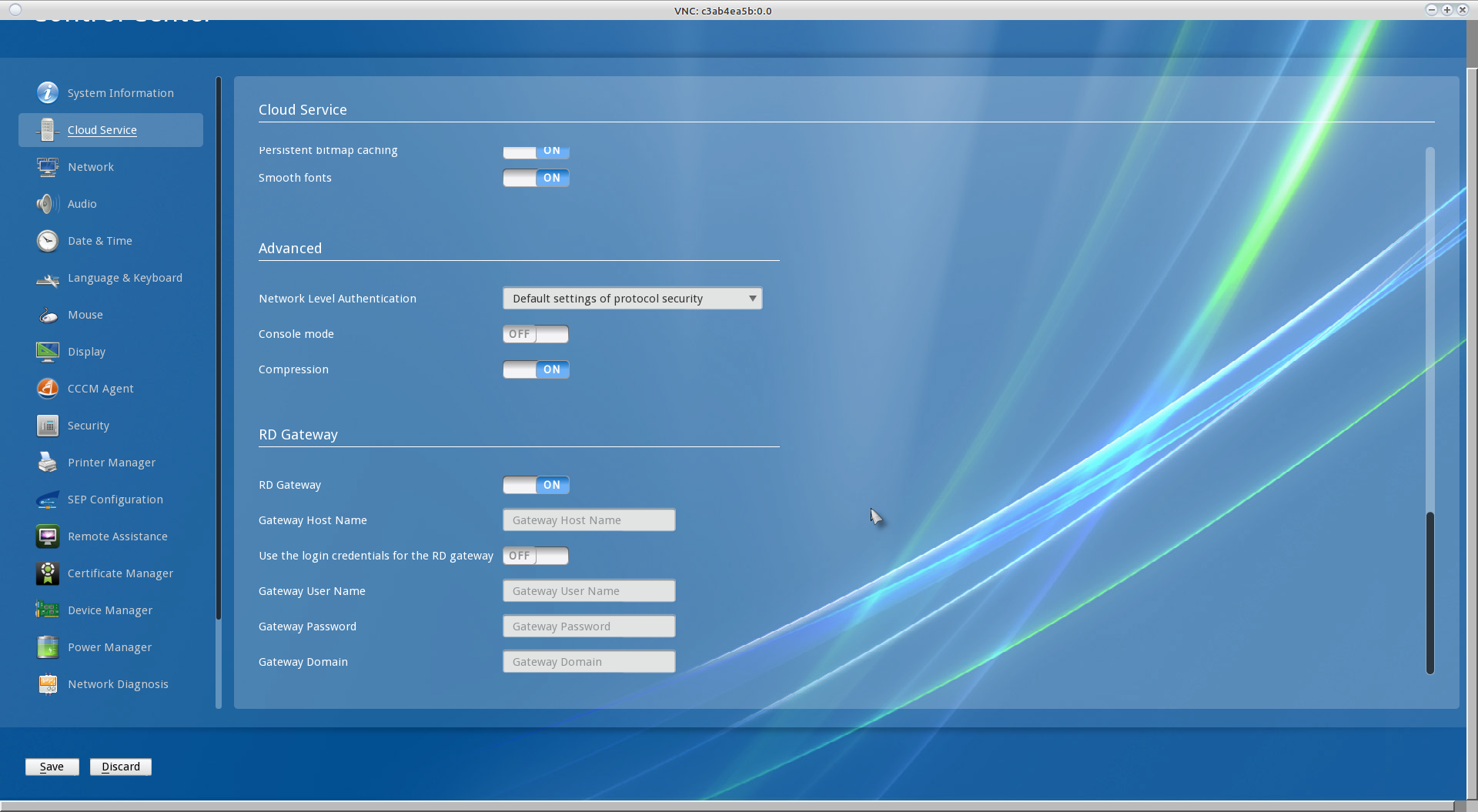

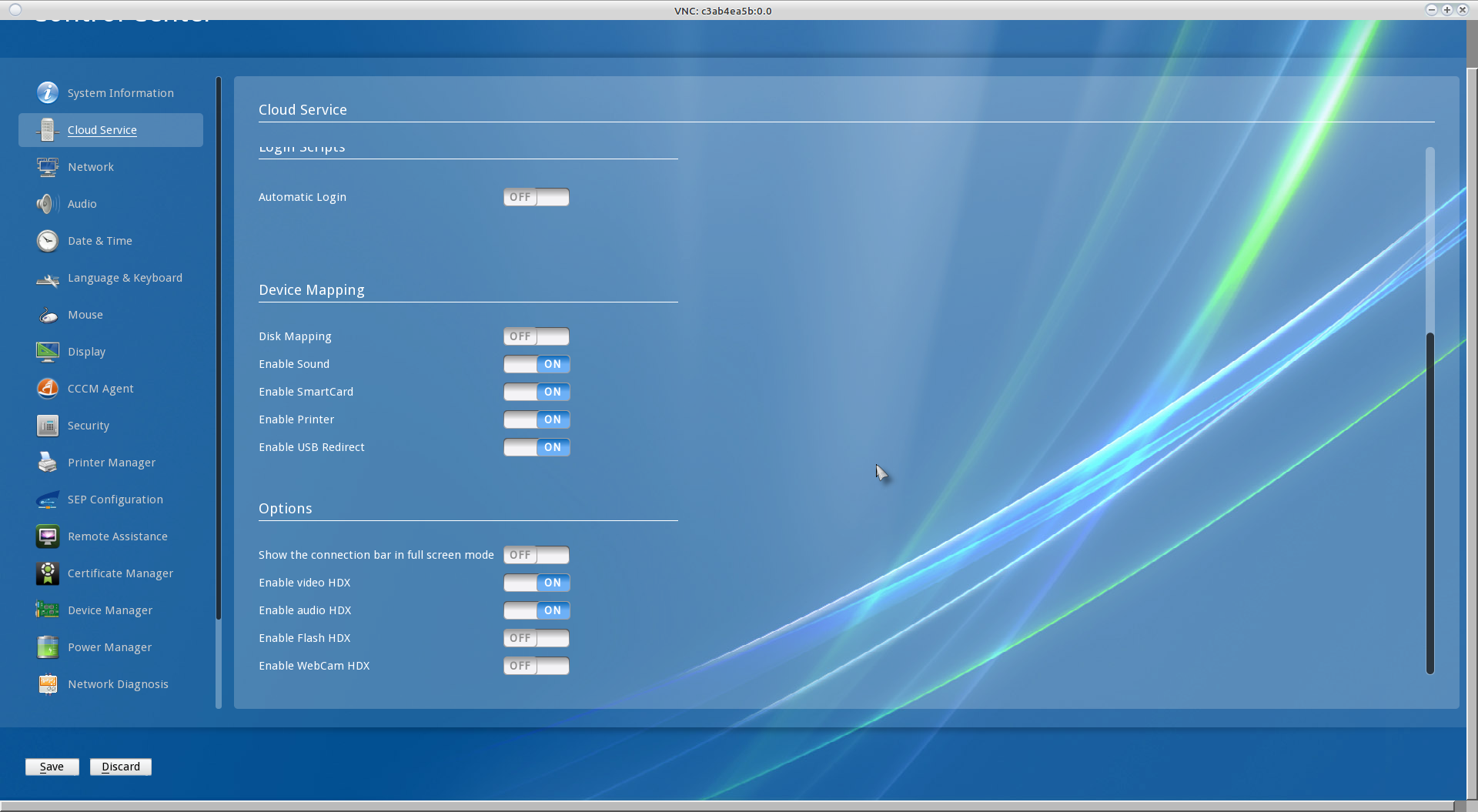

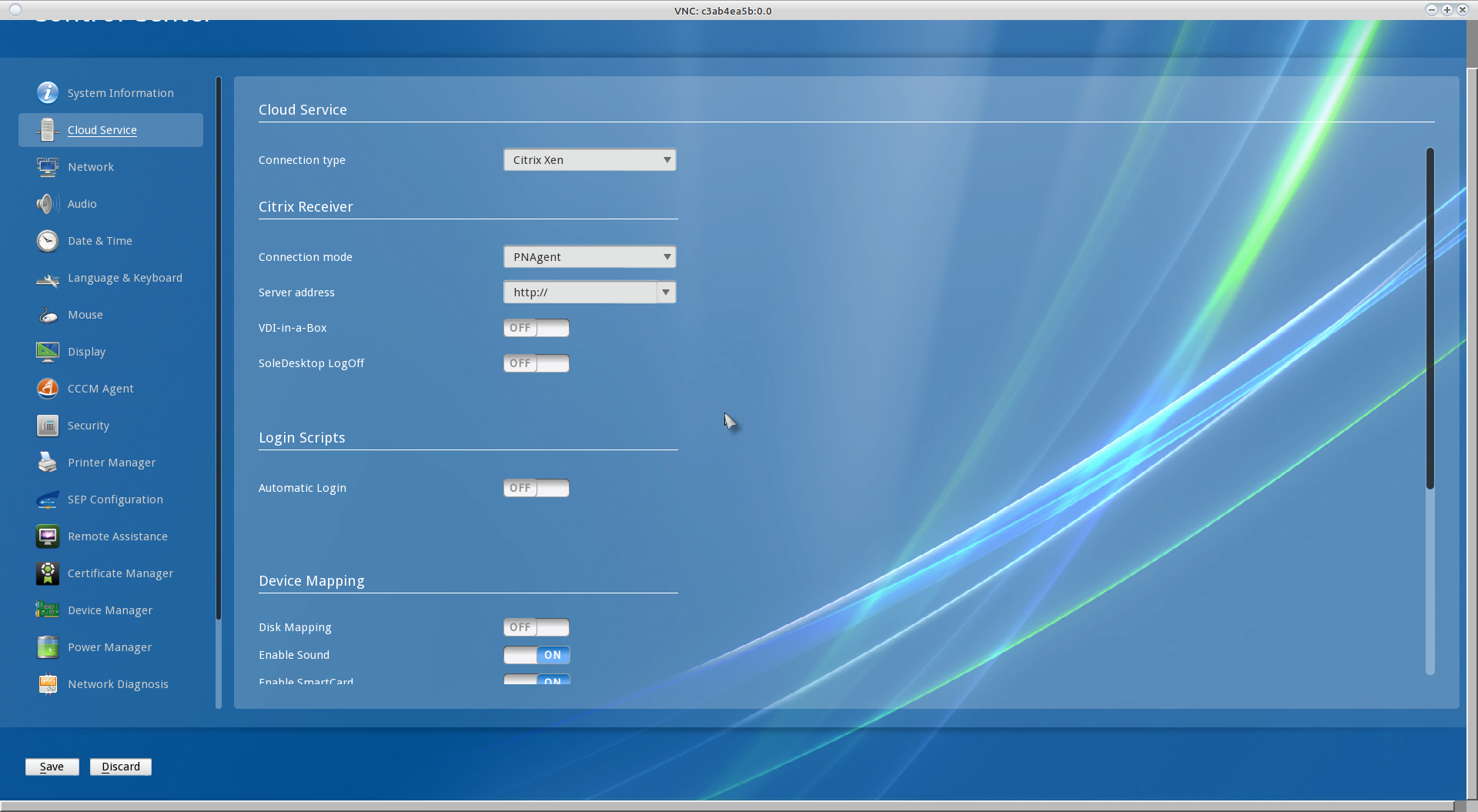
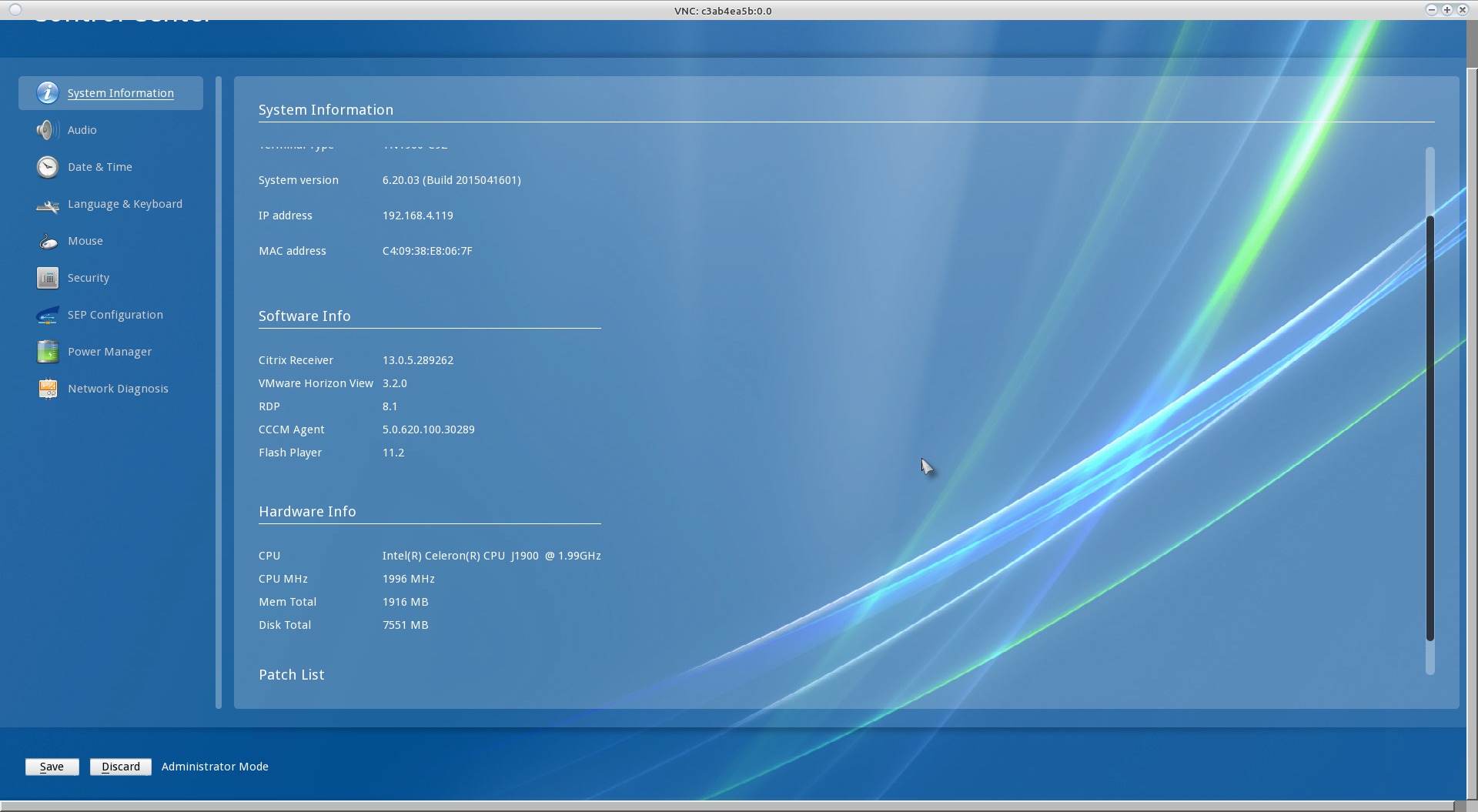

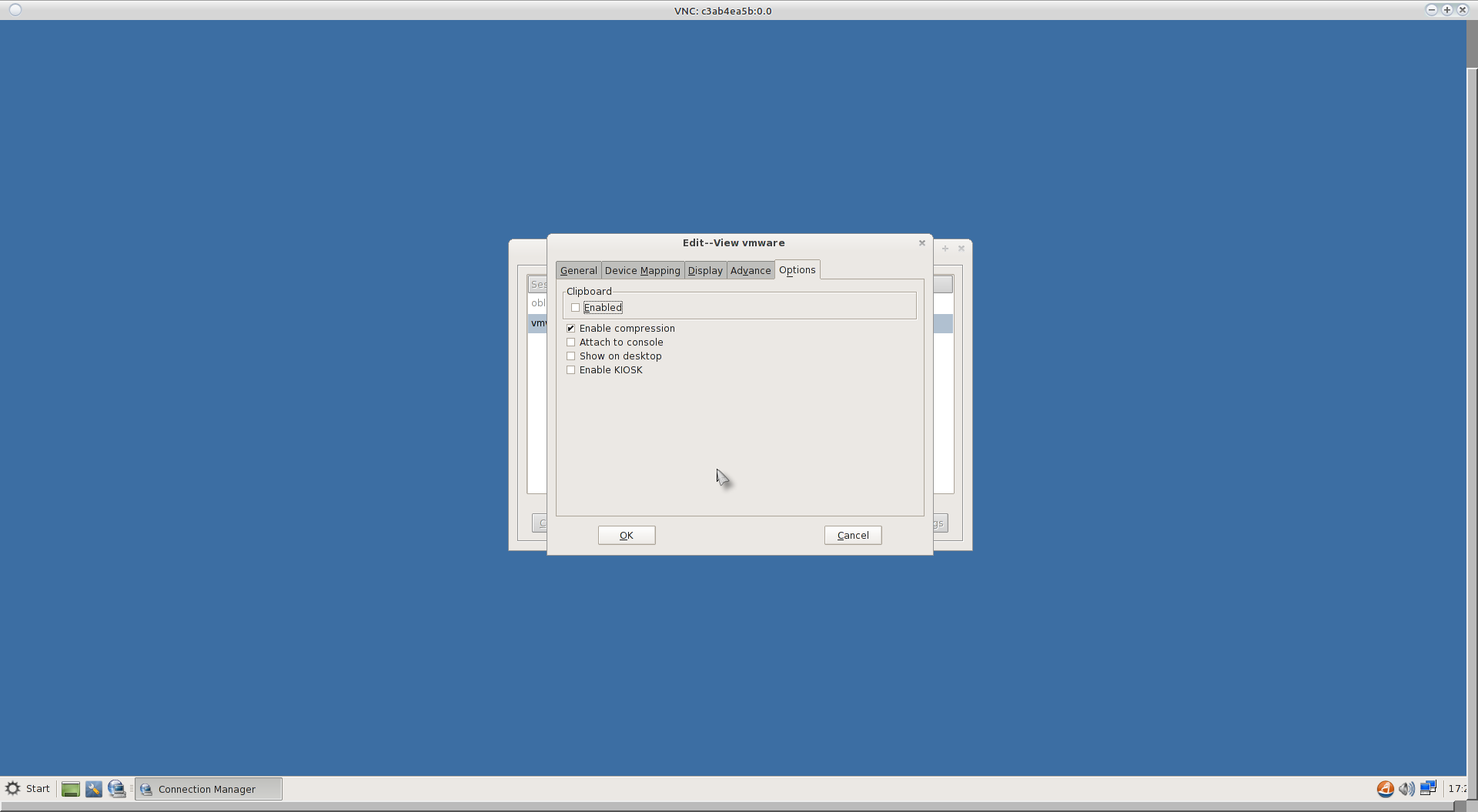
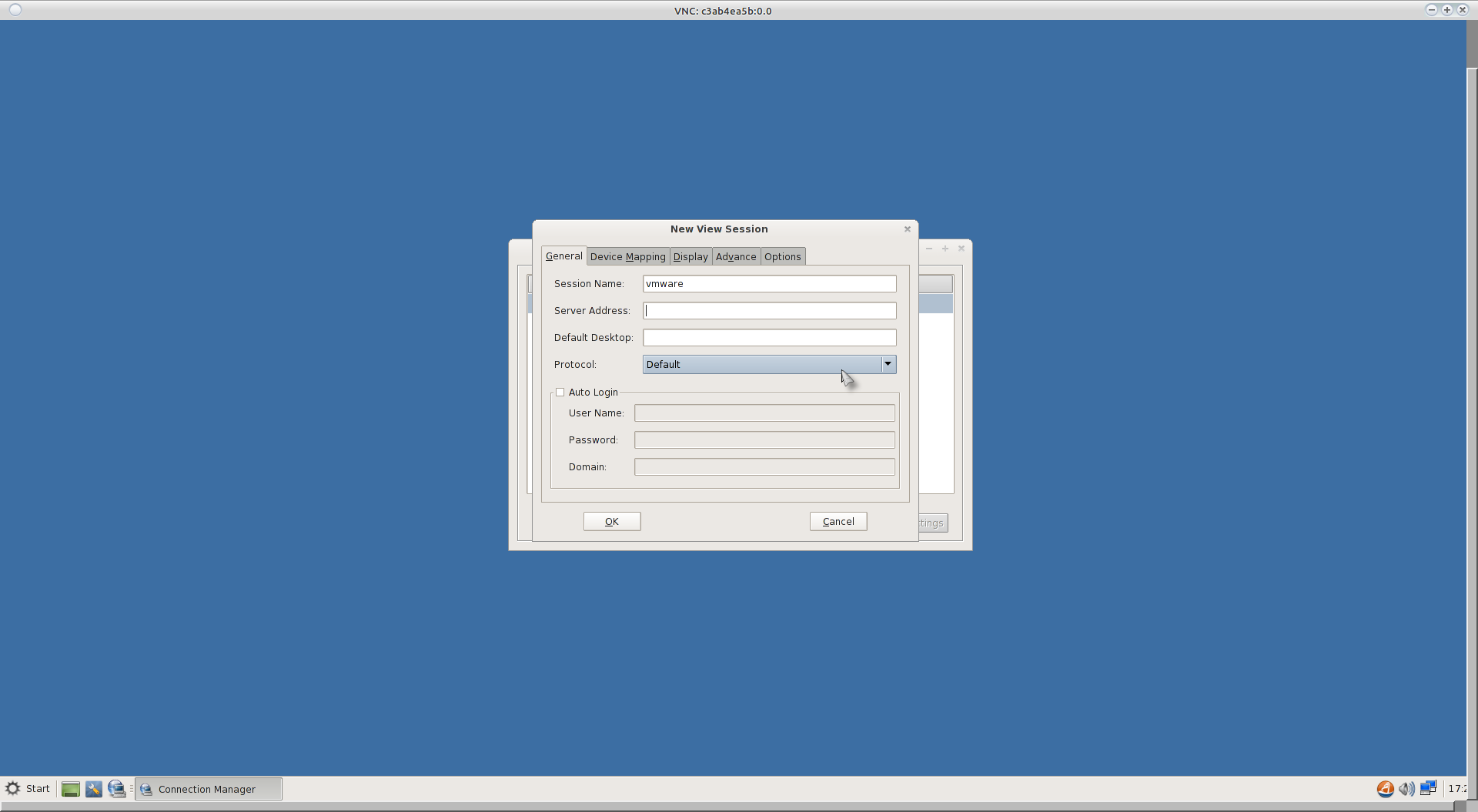
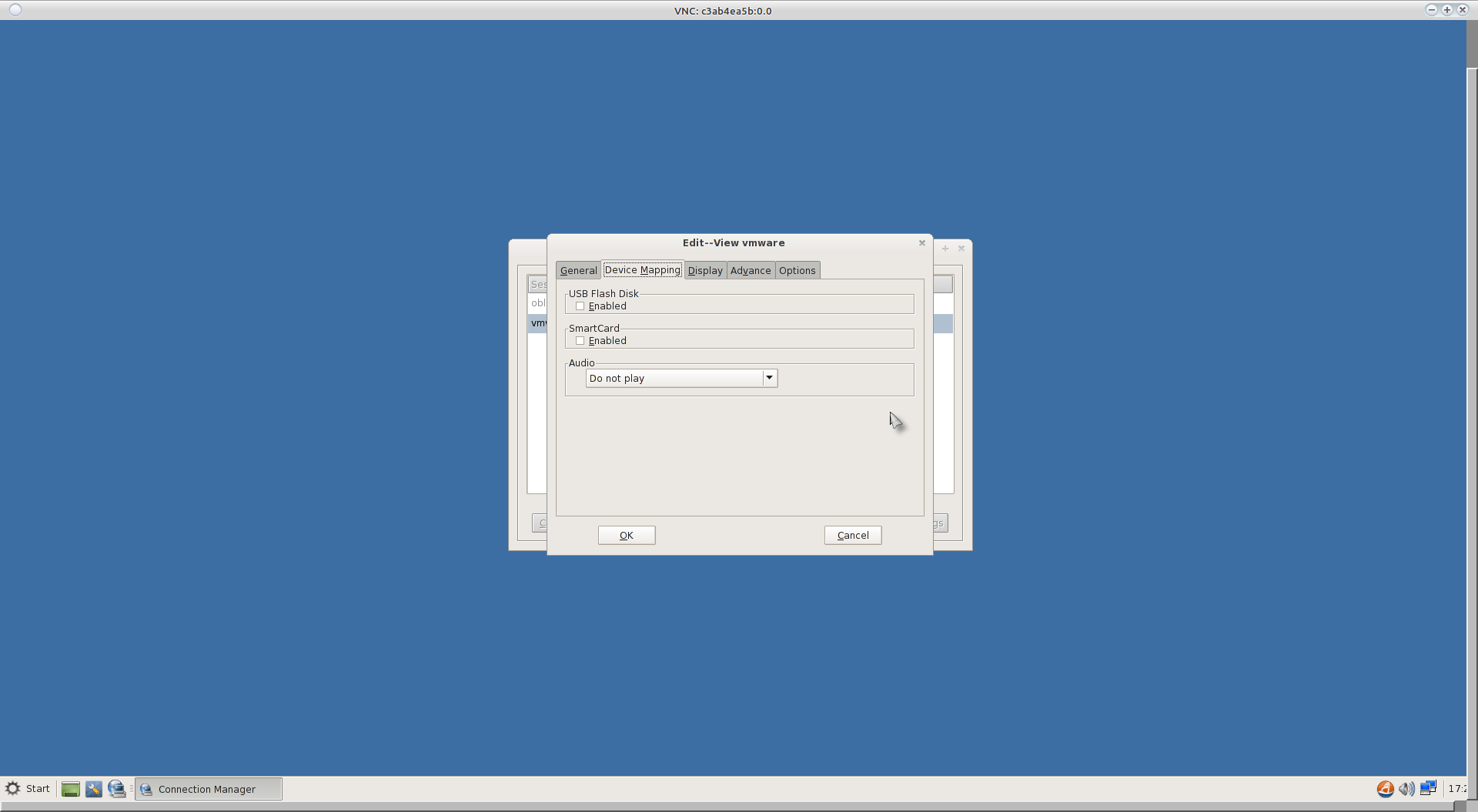
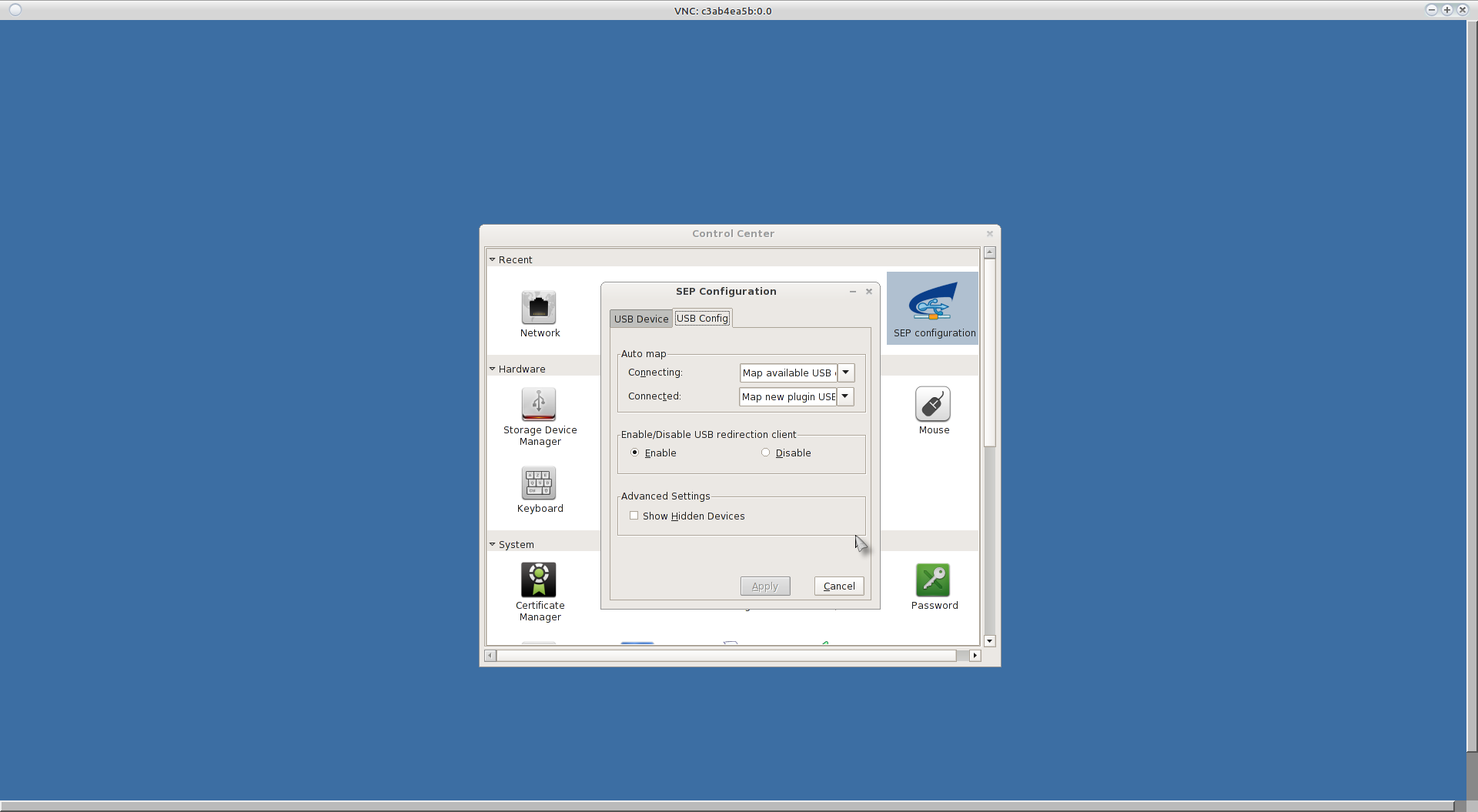
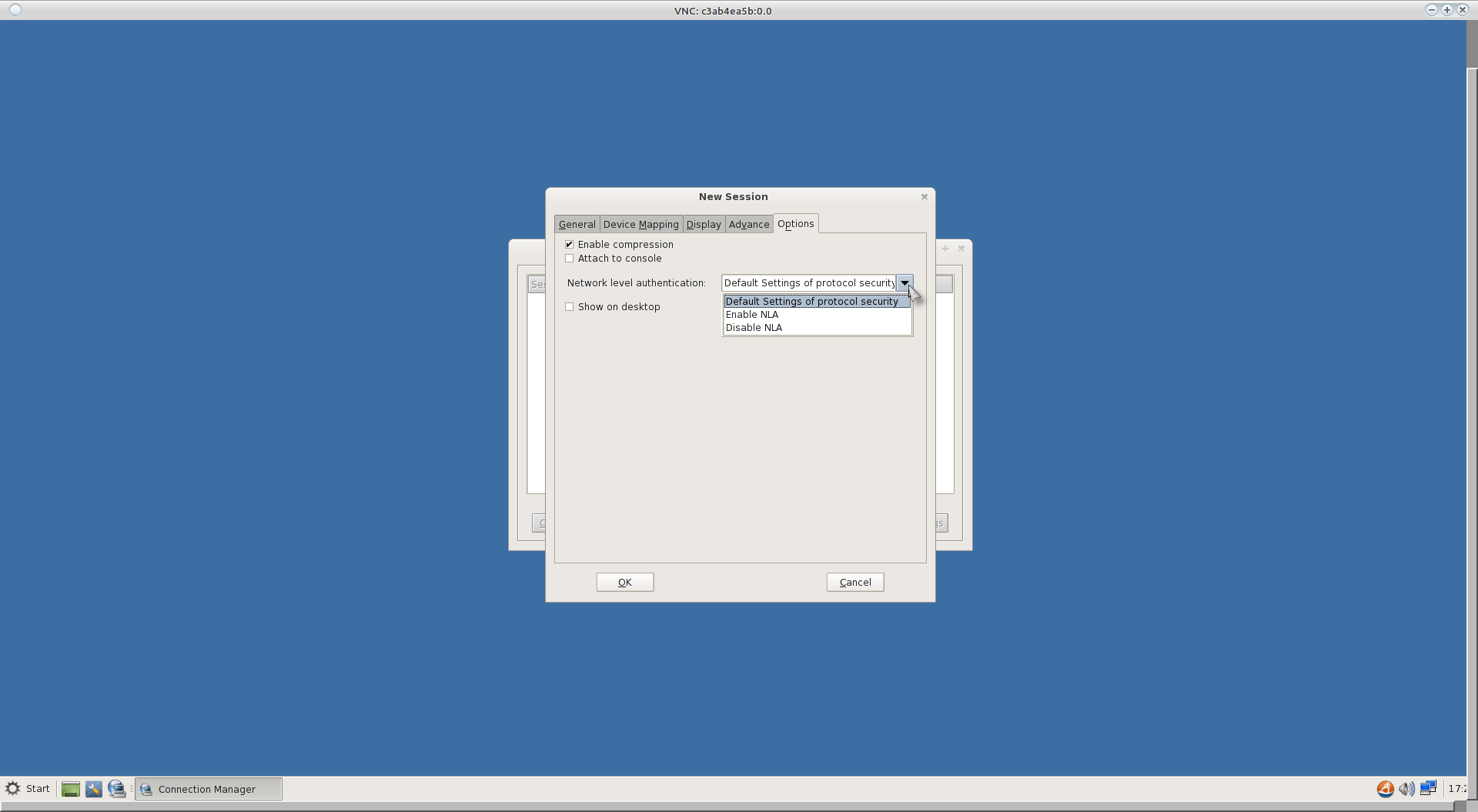
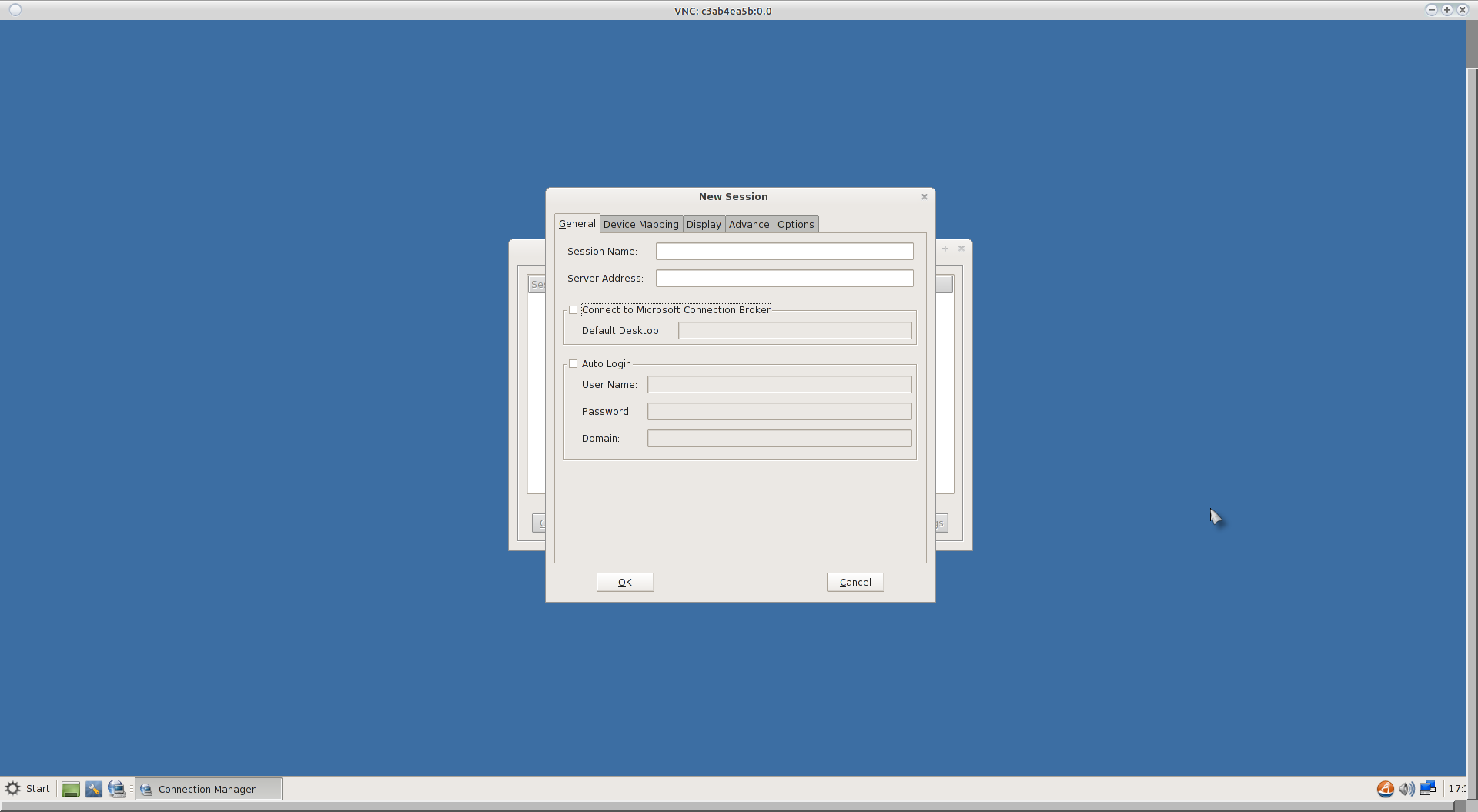
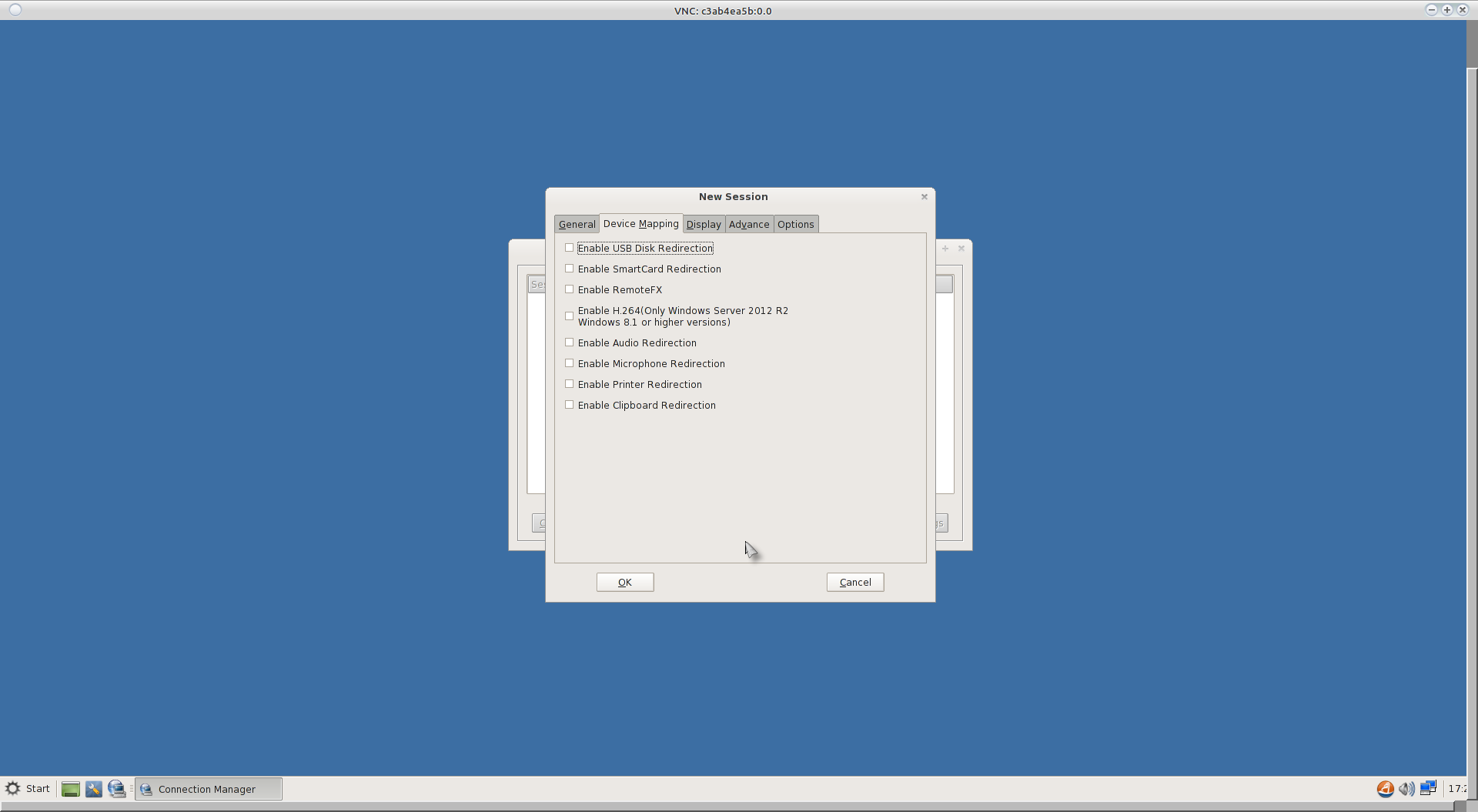

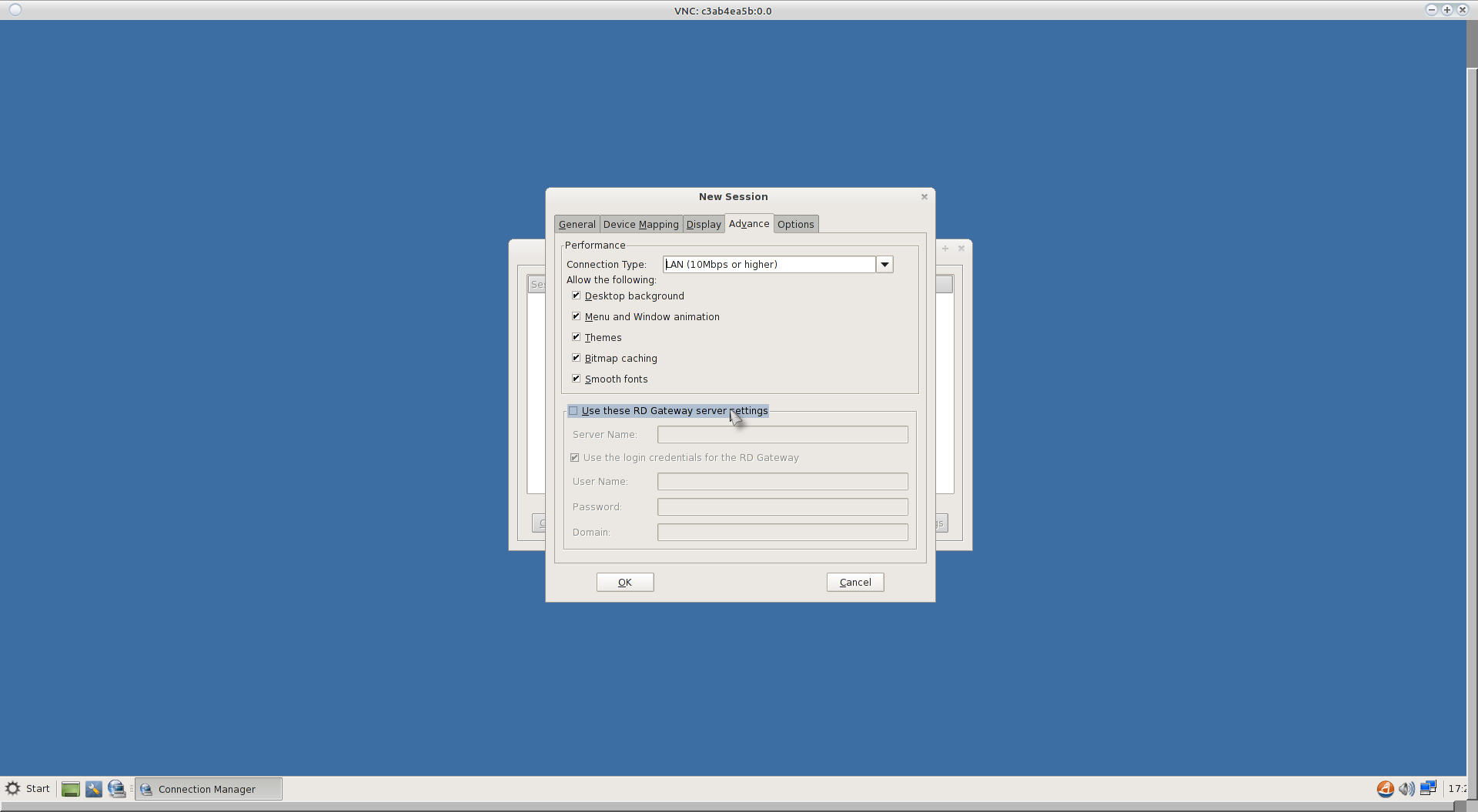


Of course, this device is not intended for games, work with graphics and other resource-intensive tasks, but copes with the average office use without any problems.
The price on the manufacturer's website is 13,650 rubles. Is it a lot or a little? On the one hand, this is not so little (although any more or less decent smartphone costs more). On the other hand, for this money it is not so easy to find competitors. One of them is Lenovo:

This is a thin entry-level client based on an ARM processor, which in itself imposes certain limitations. You can also connect only one monitor. In our subjective opinion, the appearance and quality of the materials used leave much to be desired.
We did not set the goal of this article to convince you of the advantages of thin clients for doing business - the topic is not new, many enterprises have been using them for many years. But we decided to draw your attention to the very competitive decisions of the Russian manufacturer - as part of the policy of import substitution, this may be a very important factor in the very near future.
And continuing this topic, in one of the following articles we will show the assembly of the domestic AltLinux , which has several advantages compared with competing solutions. Namely:
- local printing on cheap printers is supported;
- bidirectional sound;
- redirection of webcams, scanners and other local devices to a remote system;
- support of information security tools (trusted boot modules, two-factor authentication hardware).
For now, we are ready to answer your questions in the comments.
In the broad sense of the word, “Thin Client” is any software or hardware tool that allows operation in the terminal mode. This implies the existence of a server that performs all the calculations, as well as organizes a virtual workplace. A thin client needs to be distinguished from a “fat client,” which uses its own computational power, and the server only uses it to store data.

')
The most interesting are the so-called hardware thin clients - devices that mostly differ from the classic PC in that they do not have a hard disk and use a specialized local operating system, the main task of which is to organize access to a remote desktop.
A thin client must not have moving parts in its composition, be compact, have low power consumption and its cooling must be completely passive.
From here following advantages follow:
- Cost saving IT support;
- Savings on licenses;
- Reducing electricity costs (up to 90%, typical energy consumption of a thin client is 8-20W, as opposed to 150W for a PC);
- All security-related hardware upgrades, software updates are done only in the data center;
- Centralized backup;
- Clients are protected from viruses and unauthorized software;
- Clients are protected from copying confidential data.
Today we will talk about the TN1202 thin client from the Russian company TONK. This is the youngest model in the Lenaze 1200, which also includes the TN1207 and TN1221 .
Packing and equipment
The device is sold in a compact corrugated cardboard box. All components of the delivery kit are neatly fixed in place using packaging elements made of polyethylene foam.

The package includes a power supply, an adapter from DVI-D to VGA, a VESA mount, a stand for vertical installation and an optional adapter from DVI to two monitors (DVI + DSUB),

The package bundle is not bad - unlike the competitors, it even has a VESA-bracket - to put it simply, there is everything to deploy the workplace, nothing more is needed. For obvious reasons, it was hardly necessary to include a keyboard, a mouse and a monitor in the kit.
Power supply - external. It is a universal (110-230 V) AC adapter, input voltage 12 V, maximum current consumption 3 A. Thus, the maximum power consumption 12V x 3A = 36W.

The external power supply in this case is preferable to the internal one, since this is the only place in the system that can theoretically fail. Of course, replacing it is much easier than sending the entire device to service.
Now let's move on to our “Thin Client”.
Specs
- Operating system: TONK Embedded Linux
- Processor: AMD APU T40N (2-Core 1 GHz 9W)
- Disk Memory: 8GB mSATA, up to 64GB
- Memory operative: 1GB, up to a maximum of 4GB DDR3
- Interfaces: DVI, VGA
- Number of connectable monitors: 2
- 7x USB2.0
- Network Adapters (GE) 1
- Headphone jack
- Microphone jack
- Graphics: AMD Radeon HD 6290
- Maximum resolution: 1920x1080
Appearance and quality of performance


The device looks very stylish - one feels that they have worked on the design. Slightly spoils the impression of the color connectors of the microphone and headphones, but it would be strange if they were not. Also, metal instead of gray plastic would make a better impression. However, this is all subjective, and the practicality of color marking to someone may seem more important.

The quality of assembly and materials is at a high level, when you try to deform the device, nothing creaks or backlash.


It stands out in a very compact size (31x167x131 mm), and with a modest weight - a little more than half a kilo. On one side is the “Kensington lock” connector, designed for anti-theft mounts (which is the standard in the corporate segment).



The front panel, in addition to the company logo, contains a USB port, headphone and microphone connectors, as well as a power button, combined with an LED indicator.

On the reverse side there are expansion connectors (from left to right): 2xUSB (2.0), Ethernet, again two USB, DVI, and two more USB ports and a power connector.

The photo is visible information plate, which is removed inside the case - it shows the model name and serial number. It is very convenient to place on it the inventory number, which is usually the IT-department glues everywhere.
Installation options
The device can be installed in several ways - to whom it is more convenient. For example, just horizontally:

Or vertically as a nettop (using a stand from the kit):


But the most elegant, in our opinion, installation option, which many other desktop systems cannot boast with is a VESA-bracket (the distance between mounting holes of which is 75x100 mm). This allows you to attach the device to most modern monitors - just twisting the screws through the adapter to the back of the monitor.

There are two colors to choose from:


Cooling system
In a separate paragraph, I would like to mention a completely passive cooling system - this is one of the key advantages of thin clients. In large open spaces, even minimal noise from laptops and PCs merges into one annoying hum, which by the end of the working day is very tiring.
In addition, the lack of fans will not allow the system to fill the interior with dust, which means that you can save on periodic maintenance (cleaning).
SoC (System-on-chip) AMD Embedded G-Series
AMD system-on-chip for embedded applications includes on a single physical substrate
- x86 computing core
- Out-of-Order Instruction Execution
- SSE1,2,3, SSSE3 ISA, SSE4A, MMX
- 32kB L-cache, 32kB D-cache, 512kB L2 cache per core - DDR3 memory controller supporting frequency up to 666 MHz (up to 1333 MT / s) and low latency
- Support graphics core:
- 2D acceleration (128-bit architecture capable of processing several pixels per clock)
- 3D acceleration (DirectX 11, Shaders Model 5, OpenCL 1.1, OpenGL 4.0
- Embedded H.264, VC-1 and MPEG2 decoding - I / O controller
Many may have a question about the appropriateness of using x86-processor (especially dual-core) in the thin client. It may be unnecessary to transfer a remote desktop image from the server, but as a rule, it is useful to have locally at least a browser, an instant messaging tool and an audio-video conferencing program for which certain computing power will not be superfluous.
Turn on and work
When you press the power button, the successful device initialization is accompanied by a short loud squeak of the system dynamics.
System loading is very fast - the process takes about 7 seconds. There are no problems with connecting two monitors. The only point is that during the initial loading the image on the screens is duplicated - in the settings you need to select “Extend the desktop”.
If the device is not connected to the local network, the first thing that the user sees is a message about the need to insert a network cable.
operating system
The TN1202 client ships with TONK Embedded Linux operating system. Pre-configuration of connections to remote desktops and applications on the operating system (OS) pre-installed on the TN1202 TONK is possible as in the "kiosk" mode:

So in the “quasi-zero” client mode:

The second mode is possible both for working with Microsoft Remote Desktop Server resources and in Citrix and VMWare virtualization environments. After switching on the TONK, the user immediately enters the necessary application or virtual machine on a remote server, without displaying unnecessary interfaces.
A few more screenshots from the device for self-study (clickable):





















Of course, this device is not intended for games, work with graphics and other resource-intensive tasks, but copes with the average office use without any problems.
Price
The price on the manufacturer's website is 13,650 rubles. Is it a lot or a little? On the one hand, this is not so little (although any more or less decent smartphone costs more). On the other hand, for this money it is not so easy to find competitors. One of them is Lenovo:

This is a thin entry-level client based on an ARM processor, which in itself imposes certain limitations. You can also connect only one monitor. In our subjective opinion, the appearance and quality of the materials used leave much to be desired.
Conclusion
We did not set the goal of this article to convince you of the advantages of thin clients for doing business - the topic is not new, many enterprises have been using them for many years. But we decided to draw your attention to the very competitive decisions of the Russian manufacturer - as part of the policy of import substitution, this may be a very important factor in the very near future.
And continuing this topic, in one of the following articles we will show the assembly of the domestic AltLinux , which has several advantages compared with competing solutions. Namely:
- local printing on cheap printers is supported;
- bidirectional sound;
- redirection of webcams, scanners and other local devices to a remote system;
- support of information security tools (trusted boot modules, two-factor authentication hardware).
For now, we are ready to answer your questions in the comments.
Source: https://habr.com/ru/post/368827/
All Articles